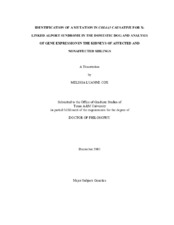| dc.description.abstract | The domestic dog, Canis lupus familiaris, plays many roles in the lives of humans. Additionally, the dog is recognized for its potential as a model for many human hereditary diseases. Thus, the genetics and genomics of the dog are being studied extensively in order to facilitate its use as a model, as well as to help the dog for its own sake. As part of this research effort, our laboratory has added type I markers (i.e., the acidic and basic keratins, c-kit, type I and IV collagens, and the gene encoding uromodulin) to the emerging map of the canine genome. The mapping of genes, particularly those in large gene families such as the collagens, is valuable because it rapidly increases the density of gene loci on the map and provides insight regarding conservation of synteny between the dog and other mammals. The major focus of work reported here is the genetics of X-linked Alport syndrome (XLAS), a terminal renal disease that affects the human and the dog. The disease results from mutations in COL4A5, a type IV collagen gene. Reported here are the 1) sequencing and mapping of the canine cDNA encoding uromodulin, 2) mapping of the type I and type IV collagen genes, 3) sequencing of the full-length cDNA of canine COL4A5, 4) identification of a 10 bp deletion in COL4A5, causative for XLAS in our colony of mixed breed dogs, 5) development of a genetic test for identification of affected and carrier dogs in the colony and 6) assessment of gene expression in the kidneys of normal and XLAS-dogs. This assessment was performed using a canine-specific oligonucleotide microarray. XLAS dogs demonstrated up-regulation of many genes involved in extracellular matrix reorganization, cell structure, and immune response, as expected in a glomerulopathy with tubulointerstitial nephritis. Trends were verified by quantitative RT-PCR. A review of the current status of canine genetics research, and current understanding of hereditary diseases in the dog, concludes this dissertation. | en |


